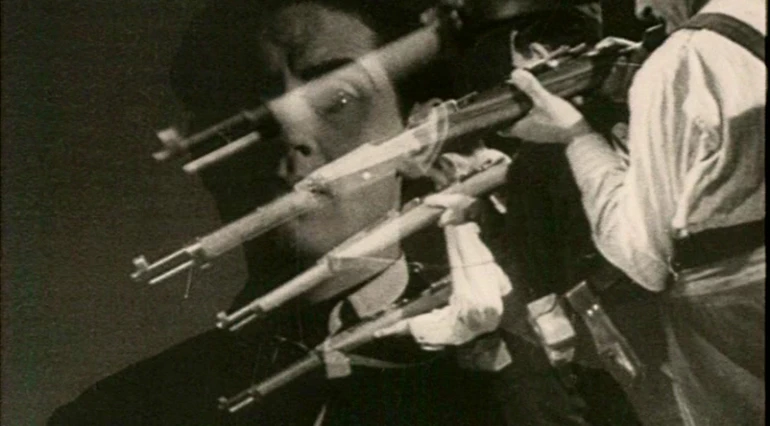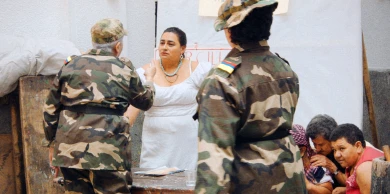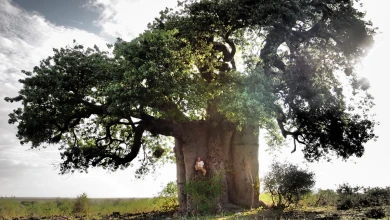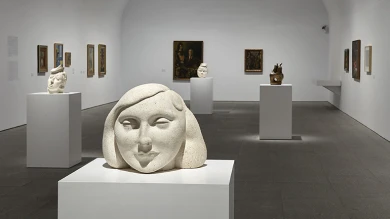-
April 28, 2016
Rafael Gil. El hombre que se quiso matar (The Man Who Wanted to Kill Himself)
1942, original version, b/w, 93´
With a presentation by María Dolores Jiménez-Blanco, the curator of Campo Cerrado. Spanish Art 1939–1953 and professor of Art History at the Complutense University of Madrid.
In this film bitterness and critique seeps through the social fabric of comedy without hesitation, establishing an initial symbiosis of realism, costumbrismo and fantasy that would characterise a large part of post-war film texts.
Freed from social conventions after publicly deciding to commit suicide, Federico Solá, a young and brilliant architect without a future, becomes a danger and a source of irritation to the social fabric, comprising a journalist, an entrepreneur, a shopkeeper and an bourgeois loafer, who all come together as they anxiously await the consummation of the final promise. The afflictions of an isolated country in moral and economic collapse is, time and again, laid bare and exploited with the construction of this uncontrollable character which nothing can deny, and through dialogues – halfway between a one-act farce and the grotesque - that help to understand the masterly consideration of Wenceslao Fernández Flórez, the author of the novel which inspired the film, by the comedians of La Codorniz.
-
April 29, 2016
Carlos Arévalo
Ya viene el cortejo… (Here Comes the Parade…) 1939, original version, b/w, 11´
Rojo y negro (Red and Black), 1942, original version, b/w, 80´
The joint screening of both films affords a glimpse into the difficulties facing the new Regime in mobilising propaganda cinema, due to both the different ideological trends behind the military uprising and the syncretic and contradictory sources of Spanish fascism.
Ya viene el cortejo… shows the 1939 Victory March as it searches for its roots in the historical and iconographical motifs that seek to become immemorial. The film sets out to explain how the perfect and triumphant military formations in the march – seen in high-angle avant-garde shots – reach their fullest sense with fades back to an eternal past of medieval castles, cathedrals, religious symbols, and stereotypes of women wearing regional Spanish garments.
Rojo y negro, on the other hand, maintains Carlos Arévalo’s extreme experimental volition. Lost for over forty years and turned into an example of formal radicalism by historiography, the film bears witness to the extraordinary density of a genuinely Falangist work, whose visual findings and extreme formal avant-gardism see it become a kind of cinema substantiated by certain revolutionary sectors inside the Falange, before its ultimate domestication by the Regime. Written and directed by Arévalo, the film deploys dialectic and visual mechanisms of Eisenstein’s intellectual montage, even incorporating images from Battleship Potemkin (1925) to give filmic shape to the “need” for revolt.
-
May 5, 2016
Edgar Neville
Verbena (Madrid Carnival), 1941, original version, b/w, 30´
La torre de los siete jorobados (The Tower of the Seven Hunchbacks), 1944, original version, b/w, 99´
With a presentation by José Luis Castro de Paz, curator of the series and professor of Audiovisual Communication at the University of Santiago de Compostela.
The work of Edgar Neville, perhaps the most important film-maker from this decade, adopted a process which appropriated elements of popular culture in Spain, reformulating them into a new mode of expression. The joint screening of Verbena (1941) and La torre de los siete jorobados (1944) notes how minor popular forms, the serialised novel, the police novel, purist costumbrismo, and the one-act farce, with direct allusions to avant-garde movements, co-exist in these films.
Verbena, produced within a series of small cinematic dramatizations inspired by popular songs, describes a dark and touching microcosm comprising the anomalous alliance between the working classes and eccentric artists from circus. The other screening, La torre de los siete jorobados, synthesises a purist criminal tale with traits that are directly rooted in German Expressionism. The film combines two opposite worlds: on one side, the nocturnal, fantastical and bizarre, embodied in this inverted underground tower inhabited by deranged sages, dwarfs and hunchbacks exiled from the light. And on the other, the costumbrista and comic sketch from Madrid, much-loved by the film-maker; this time set in the last third of the 19th century.
-
May 6, 2016
Ignacio F. Iquino. Los ladrones somos gente honrada (We Thieves Are Honourable)
1943, original version, b/w, 102´
This film constitutes a paradigmatic example of the paradoxical and reflexive trend cultivated in the first post-war period and emerging from the complex melange between film and comical and visual resources stemming from absurd and avant-garde humour. With filmic precedents already in the Republican period, the model reached its definitive formulation at a time that coincided with the appearance of the renowned humorous magazine La Codorniz.
Deliberately artful and farcical, Los ladrones somos gente honrada is a parody of the plausibility of classical cinema as it breaches each of its norms. Everything operates in double meanings, paradox, antithesis and two faces that are entangled to fever pitch - “this house is a film”, one of the characters even utters. In a meandering and scattered way, the film pulls us out as viewers and drops us into the scene, or, similarly, dismantles the transparency of orthodox narrative to benefit our strengthened role as participants in an artificial and distant event.
-
May 12, 2016
Arturo Ruiz-Castillo. Las inquietudes de Shanti Andía (The Restlessness of Shanti Andía)
1946, original version, b/w, 121´
A collaborator of Federico García Lorca in La Barraca, art director of the publishing house Biblioteca Nueva and cultural spokesperson during the Republic, Arturo Ruiz-Castillo already had vast experience as a documentary-maker before debuting as a feature-film director with the adaptation of Las inquietudes de Shanti Andía (1946).
The film displays eye-catching discursive and formal strategies (narratological rigour, the deployment of the storyline in independent sequences that match the character’s psychological development, ornamental and compositional symbolism, inter-textual traits…) which bear witness to the artistic ambition of a director encompassed in the generation of “reformist” film-makers who, with vivid and bold aesthetic preoccupations, made their debut in the second half of the first decade under the France regime. Audaciously using Pío Baroja’s novel to discuss the present, the film turns oedipal conflicts and anxieties of desire into effective narrative copies of an unlivable time.
-
May 13, 2016
Carlos Serrano de Osma. Embrujo (The Spell)
1947, original version, b/w, 80´
Carlos Serrano de Osma is the visible leading figure in the self-styled “telluric” cinema, an informal circle of friends brought together around the magazine Cine experimental (1944–1946). A film-maker of enunciation and point of view, his films from this period incorporate the European legacy of Eisenstein and Pabst, and the American legacy of Welles, Siodmak and, above all, Hitchcock in a dense corpus of literary references and iconographic, autochthonous references, creating a poetic narrative style strongly imprinted with psychoanalysis.
Embrujo manages to – in the film-maker’s declared intention – “reach the shadows of the unconscious through the brilliant routes of folklore.” The film, a musical drama that is explicitly surreal, heart-rending and a moving reflection on desire and delirious passion, pieces together a highly risky operation in the film industry: combining the popular and the avant-garde, using the former as a cushion for the second.
-
May 19, 2016
Lorenzo Llobet-Gràcia. Vida en sombras (Life in the Shadows)
1948, original version, b/w, 90´
Punished to the point of ostracism by the censorship that would classify it as “inconceivable, unacceptable, inadmissible and disgraceful”, Vida en sombras is perforated by the trauma of the Civil War, which fights to make itself present. The beginnings of the conflict are narrated from the Republican side: news fragments from the time and a speech in Catalan by the president Companys are heard on the radio. In this milieu, the loss of the object of desire, embodied by the character Ana, who dies in the first skirmishes on the Barcelona streets, is bound up with unique force; thus tracing the stark identification between the harsh post-war period and the loss and scarring of the subject.
War, death, the incurable wound of desire: upon these three pillars, inextricably linked by the mise en scène, the film articulate its strategies of meaning. And further still, in a new, all-engulfing circle, cinema appears as a place where the subject’s desire (film-maker, protagonist, viewer) is radically affected.
-
May 20, 2016
Rafael Gil. La calle sin sol (The Sunless Street)
1948, original version, b/w, 95´
In an audacious mix of film noir, veristic will, and a costumbrista background, this distinctive thriller joins a series of obsessive and dense post-war films with sharp psychoanalytical resonances. Set in the desolate and poverty-stricken night-time of Barcelona’s Chinatown, inhabited by long-suffering survivors without hope, the story delves into dark crimes and destroyed families, and stresses the recreation of lumpen settings in the Catalan capital, depicted as a place of prostitution and illegal trade, where the residents represent at once the danger of extortion and the possibility of help. What ultimately emerges, via the film’s formal density, is a textual fabric torn at its seams, and understood as a symptom of the unconscious repression in the ruling classes in the face of social decomposition and rotting morals after the war.
-
May 26, 2016
Juan de Orduña. Locura de amor (Madness for Love)
1948, original version, b/w, 112´
The historical works directed by Juan de Orduña are the most original, complex and contradictory confluence of ideological interests from the Regime, from the eagerness for pomp and majesty from the producer CIFESA and from the tastes of the actual spectators. Locura de amor would constitute the greatest audience success of the season and one of the greatest in this decade; the “Spanishness” of these sorts of films was favoured by a large number of critics who saw in the historical literary, and not folkloric, adaptation a place in which film would have to redefine itself. The reasons for its undeniable popular allure were in its markedly melodramatic volition, characterised by the prominence of the suffering female figure. Built as a monumental and literal succession of living paintings, Locura de amor seeks to breathe life, not into events in History with a capital H but into the signs that have gone some way to building a romantic and timeless legend of the love story of Juana la Loca and Felipe el Hermoso.
-
May 27, 2016
José Antonio Nieves Conde. Surcos (Furrows)
1951, original version, b/w, 99´
The direct appearance of questions related to a lack of housing, unemployment, prostitution and rural exodus, in addition to the direct relationship with models of film such as Italian Neo-realism, define the exceptional nature of Surcos, both in this decade and generally throughout the history of Spanish cinema. The film’s emotional tension places it in the orbit of the film seasons that narrate the vicissitudes of a group of characters in a hostile environment, in an occupied country, a besieged city, an idea that manifests itself through the reiterated visual motif of furrows (prison bars, farmyard steps, an open grave, a ploughed field). On one side, claustrophobic confinement in small, shared spaces that are overpopulated or inhospitable; and on the other, an urban prison in which one cannot settle, feel at home and rest. Each sequence is structured through an exit or arrival, repeating the transition to nowhere that underpins the film to the grave, the final furrow.
Life in the Shadows. Spanish Cinema in a Labyrinth (1939–1953)

Held on 28, 29 Apr, 05, 06, 12, 13, 19, 20, 26, 27 May 2016
This film series, organised in conjunction with the exhibition Campo Cerrado. Spanish Art 1939–1953, focuses on post-war Spanish cinema, moving beyond the clichés that have buried it for a number of decades to present a dark yet fascinating filmic and historical labyrinth displaying conflicts, searches and objectives from the main narratives in a melancholic period, wounded and confrontational period.
The dictatorial regime organised film production in a diametrical opposite to the Republican period as it developed a system of economic autarchy and staunch ideological censorship. Nevertheless, contrary to widespread assertions, it also searched for continuity in the cultural traditions that had been put in place during the Second Republic. The new State failed, however, in its aim to construct “fascist” cinema on account of the disparity of conflicting views, thus demonstrated in the differences between long-standing conservatism in Raza (Race), by José Luis Sáenz de Heredia (1942), and the Falangist and Eisensteinian modernity of Rojo y negro (Red and Black), by Carlos Arévalo (1942). It would also err in its attempts to remove the folkloric and popular substrata which, despite fierce opposition by those who saw such elements as an abominable Popular Front-esque inheritance, managed to remain and was depicted in the work of director Edgar Neville - a pragmatic and measured cultural opposition with authentic and subversive titles like Verbena (Madrid Carnival, 1941), La torre de los siete jorobados (The Tower of the Seven Hunchbacks, 1944) and the Solanesque Domingo de carnaval (Carnival Sunday, 1945).
Despite the darkness of the period, comedy would become the most common genre. Drawing influences from the modern and absurd humour found in the magazine La Codorniz (founded in 1941 by Miguel Mihura), this decade’s filmography was predominated by a decidedly reflexive and meta-cinematic volition, expounding the difficulty facing fiction when it came to addressing the dark reality that had begun after the Civil War.
Dissidents in their own way, the films by the so-called “reformists” (Jose Antonio Nieves Conde, director of the transcendental Surcos (Furrows) in 1951; Arturo Ruiz-Castillo and Manuel Mur Oti) and the “tellurics” (Carlos Serrano de Osma, Lorenzo Llobet-Gràcia y Enrique Gómez), demonstrated a pronounced social concern and a striking “aesthetic commitment” – with European and avant-garde roots yet also strongly influenced by Hollywood – in addition to profound psychoanalytical concerns, conveying harrowing discourses about the life and times and the destructive consequences.
The irreparable loss of the loved object, often portrayed by a murdered, forbidden or missing woman, the ensuing melancholy and even madness and the narrative junctions that were customarily employed at the time can be read as metaphors of a devastated country, inhabited by sombre memories which carried an uncontrollable guilt complex. Thus, sadness, destruction and historical solitude became lucid “wounds of desire”.
Curatorship
José Luis Castro de Paz
Acknowledgments
Filmoteca Española
Más actividades

CLINIC 2628. A Community of Writing and Research in the Arts
February – October 2026
Clinic 2628 is a project which supports and brings together writings which stem from the intention to offer a space and sustainable time for research work in art and culture. Framed within an academic context which is increasingly less receptive to the forms in which thinking happens and is expressed, the aim is to rescue the academic from its neoliberal trappings and thus recover the alliance between precision and intuition, work and desire. A further goal is to return writing to a commons which makes this possible through the monitoring of processes and the collectivisation of ideas, stances, references and strategies.
The endeavour, rooted in a collaboration between the Museo Reina Sofía’s Studies Directorship and the Artea research group, via the i+D Experimenta project, is shaped by three annual editions conceived as spaces of experimentation, discussion and a demonstration of writings critical of what is put forward by today’s academia.
What forces, forms and processes are at play when writing about art and aesthetics? In academia, in museums and in other cultural institutions, the practice of writing is traversed by productivist logics which jeopardise rhythms of research and experimentation. The imposition of both scientism inherent in the structure of “the paper” and the quantifying of results which demand a criterion of quality and visibility sterilise and smoothen, from the outset, the coarseness that is particular to writing understood from the concrete part of language: phonic, graphic, syntactic and grammatical resistance connecting the language user to the community the language unites and activates. They also sterilise the roughness enmeshed in the same desire to write, the intuitive, clear and confusing pathways that once again connect the writer to those reading and writing, participating in a common good that is at once discovered and produced.
The progressive commercialisation of knowledge propelled by cognitive capitalism moves further away from the research and production of knowledge in artworks and artistic languages and practices. The work of curators and archive, criticism, performances and essays formerly saw a horizon of formal and emotional possibilities, of imagination that was much broader when not developed in circumstances of competition, indexing and impact. Today, would it be possible to regain, critically not nostalgically, these ways; namely, recovering by forms, and by written forms, the proximity between art thinking and its objects? How to write in another way, to another rhythm, with no more demands than those with which an artwork moves towards different ways of seeing, reading and being in the world?

The (legal) person and the legal form. Chapter II
8, 12, 15 January, 2026 – 16:00 to 19:00
As part of the Studies Constellation, the Study Directoship’s annual fellowship, art historian and theorist Sven Lütticken leads the seminar The (Legal) Person and the Legal Form: Theoretical, Artistic, and Activist Commitments to foster dialogue and deepen the hypotheses and questions driving his research project.
This project, titled Unacting Personhood, Deforming Legal Abstraction, explores the dominance of real abstractions—such as exchange value and legal form—over our processes of subjectivation, and asks how artistic practices can open up alternative ways of representing or performing the subject and their legal condition in the contemporary world.
The seminar consists of eight sessions, divided into three chapters throughout the academic year. While conceived as non-public spaces for discussion and collective work, these sessions complement, nourish, and amplify the public program of the Studies Constellation.
In this second chapter of the seminar, the inquiry into the aesthetics and politics of legal form continues with three sessions that pick up the discussions held in Chapter I but propose new lines of flight. The first session focuses on international law via the writings of the British author China Miéville, which allows us to reconsider the notion of the legal form –following Evgeny Pashukanis— and, through it, a variety of (people’s) tribunals. While the crucial concept of the legal person –as the right-holder central to the form of law— was debated in Chapter I, the second session focuses on attempts to extend personhood not (just) to corporations, but rather to nonhuman animals or ecosystems. Finally, the third session poses the question: how can groups and networks use officially recognized organizational forms (such as the foundation or the cooperative) and/or use a collective persona (without necessarily a legal “infrastructure” to match) to act and represent themselves?

Oliver Laxe. HU/هُوَ. Dance as if no one were watching you
Tuesday, 16 December 2025 – 7pm
As a preamble to the opening of the exhibition HU/هُوَ. Dance as if no one were watching you, film-maker Oliver Laxe (Paris, 1982) engages in conversation with the show’s curators, Julia Morandeira and Chema González, touching on the working processes and visual references that articulate this site-specific project for the Museo Reina Sofía. The installation unveils a new programme in Space 1, devoted from this point on to projects by artists and film-makers who conduct investigations into the moving image, sound and other mediums in their exhibition forms.
Oliver Laxe’s film-making is situated in a resilient, cross-border territory, where the material and the political live side by side. In HU/هُوَ. Dance as if no one were watching you, this drift is sculpted into a search for the transcendency that arises between dancing bodies, sacred architectures and landscapes subjected to elemental and cosmological forces. As a result, this conversation seeks to explore the relationship the piece bears to the imagery of ancient monotheisms, the resonance of Persian Sufi literature and the role of abstraction as a resistance to literal meaning, as well as looking to analyse the possibilities of the image and the role of music — made here in collaboration with musician David Letellier, who also works under the pseudonym Kangding Ray — in this project.
These inaugural conversations, part of the main working strands of the Museo’s Public Programmes Area, aim to explore in greater depth the exhibition narratives of the shows organised by the Museo from the perspective of artists, curators and specialists.

Manuel Correa. The Shape of Now
13 DIC 2025
The Shape of Now is a documentary that explores the challenges and paradoxes of memory, reparation and post-conflict justice, extending a defiant and questioning gaze towards the six-decade armed conflict in which the Colombian State, guerrillas and paramilitary groups clashed to leave millions of victims in the country. The screening is conducted by the Aesthetics of Peace and Desertion Tactics study group and includes a presentation by and discussion with the film’s director, Manuel Correa.
The film surveys the consequences of the peace agreements signed in 2016 between the Colombian State and the FARC guerrilla organisation through the optics of different victims. It was recorded shortly after this signing, a time in which doubts lingered over the country’s future, with many groups speculating in the narration. Correa harnesses the power of images, visual and bodily memory, fiction and re-staging as tools for understanding the conflict, memory and healing, as well as for the achievement of a just peace that acknowledges and remembers all victims.
The activity is framed inside the research propelled by Aesthetics of Peace and Desertion Tactics, a study group developed by the Museo’s Study Directorship and Study Centre. This annual group seeks to rethink, from a theoretical-critical and historical-artistic perspective, the complex framework of concepts and exercises which operate under the notion of pacifism. A term that calls on not only myriad practices ranging from anti-militarism and anti-war movements to activism for non-violence, but also opens topical debates around violence, justice, reparation and desertion.
Framed in this context, the screening seeks to reflect on propositions of transitional and anti-punitive justice, and on an overlapping with artistic and audiovisual practices, particularly in conflicts that have engendered serious human rights violations. In such conflicts, the role played by audiovisual productions encompasses numerous challenges and ethical, aesthetic and political debates, among them those related to the limits of representation, the issue of revictimisation and the risks involved in the artistic commitment to justice. These themes will be addressed in a discussion held after the session.

Francisco López and Barbara Ellison
Thursday, 11 December - 8pm
The third session in the series brings together two international reference points in sound art in one evening — two independent performances which converse through their proximity here. Barbara Ellison opens proceedings with a piece centred on the perceptively ambiguous and the ghostly, where voices, sounds and materials become spectral manifestations.
This is followed by Francisco López, an internationally renowned Spanish sound artist, who presents one of his radical immersions in deep listening, with his work an invitation to submerge oneself in sound matter as a transformative experience.
This double session sets forth an encounter between two artists who, from different perspectives, share the same search: to open ears to territories where sound becomes a poetic force and space of resistance.




![Miguel Brieva, ilustración de la novela infantil Manuela y los Cakirukos (Reservoir Books, 2022) [izquierda] y Cibeles no conduzcas, 2023 [derecha]. Cortesía del artista](https://recursos.museoreinasofia.es/styles/small_landscape/public/Actividades/ecologias_del_deseo_utopico.jpg.webp)
![Ángel Alonso, Charbon [Carbón], 1964. Museo Reina Sofía](https://recursos.museoreinasofia.es/styles/small_landscape/public/Actividades/perspectivas_ecoambientales.jpg.webp)